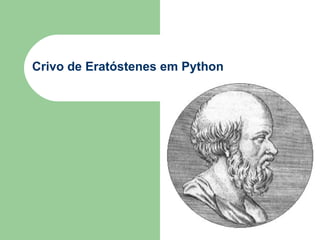Crivo de Eratóstenes - Por Rebeca Souza
•Transferir como PPS, PDF•
1 gostou•1,571 visualizações
Programa em Python que determina os números primos dentro de limite.
Denunciar
Compartilhar
Denunciar
Compartilhar

Recomendados
Recomendados
Mais conteúdo relacionado
Destaque
Destaque (20)
How Race, Age and Gender Shape Attitudes Towards Mental Health

How Race, Age and Gender Shape Attitudes Towards Mental Health
AI Trends in Creative Operations 2024 by Artwork Flow.pdf

AI Trends in Creative Operations 2024 by Artwork Flow.pdf
Content Methodology: A Best Practices Report (Webinar)

Content Methodology: A Best Practices Report (Webinar)
How to Prepare For a Successful Job Search for 2024

How to Prepare For a Successful Job Search for 2024
Social Media Marketing Trends 2024 // The Global Indie Insights

Social Media Marketing Trends 2024 // The Global Indie Insights
Trends In Paid Search: Navigating The Digital Landscape In 2024

Trends In Paid Search: Navigating The Digital Landscape In 2024
5 Public speaking tips from TED - Visualized summary

5 Public speaking tips from TED - Visualized summary
Google's Just Not That Into You: Understanding Core Updates & Search Intent

Google's Just Not That Into You: Understanding Core Updates & Search Intent
The six step guide to practical project management

The six step guide to practical project management
Beginners Guide to TikTok for Search - Rachel Pearson - We are Tilt __ Bright...

Beginners Guide to TikTok for Search - Rachel Pearson - We are Tilt __ Bright...
Unlocking the Power of ChatGPT and AI in Testing - A Real-World Look, present...

Unlocking the Power of ChatGPT and AI in Testing - A Real-World Look, present...
Crivo de Eratóstenes - Por Rebeca Souza
- 1. Crivo de Eratóstenes em Python
- 2. Eratóstenes viveu no século II a.C. Dentre os vários trabalhos que fez, destacam-se: medição da circunferência da Terra (com um erro de aproximadamente 0,2% apenas), e foi bibliotecário de Alexandria. O crivo de Eratóstenes é uma maneira prática de encontrar números primos, até um certo valor. De maneira muito simples, determina-se o número máximo até o qual deve-se verificar quais são os primos (digamos, n ). Em seguida, calculamos qual é o menor número inteiro menor ou igual a , digamos, m .
- 3. É definido assim: Escreva uma lista dos números entre 2 e o maior número que você quer testar a primalidade. Vamos chamá-la de lista1; Escreva o número 2, o primeiro número primo, em outra lista que conterá os números primos encontrados. Vamos chamá-la de lista2; Remova o 2 e todos os múltiplos dele da lista1; O primeiro número que sobrar da lista1 é primo. Escreva ele na lista2; Remova essa número e todos os seus múltiplos da lista1. A remoção pode começar da raiz quadrada do número, já que múltiplos menores foram removidos em passos anteriores; Repita os passos de 4 a 6 até não restarem mais números na lista1; A classe a seguir, escrita em Python, retorna uma lista com todos os números primos entre 2 e um número especificado ( max_n ).
- 4. PYTHON: max_n = 50 class CrivoDeEratostenes: def __init__(self, max_n): self.lista = range(2, max_n + 1) self.primo_lista = [2] self.crivo() def crivo(self): primo_n = self.lista[0] max_n = self.lista[-1] + 1 self.lista.remove(primo_n) for n in self.lista: if n % primo_n == 0: self.lista.remove(n) if len(self.lista)> 0: self.primo_lista.append(self.lista[0]) return self.crivo() else : return self.primo_lista print CrivoDeEratostenes(max_n).primo_lista # [2, 3, 5, 7, 11, 13, 17, 19, 23, 29, 31, 37, 41, 43, 47]